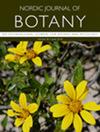瑞典的华山茜及相关树种
IF 1.1
4区 生物学
Q3 PLANT SCIENCES
引用次数: 0
摘要
我们主要在瑞典利用 DNA 微卫星对 Rubus wahlbergii 和 R. sect.Corylifolii 中的相关物种。结果表明,这些材料可分为三个物种:nordicus 分布在西海岸,一直向南延伸到斯科内省西北部,还有一个以前未被发现的类群,我们在此将其描述为 R. wahlbergioides。后者在哈兰德、斯科纳、布莱金、厄兰和斯莫兰有零星分布,但在斯科纳的基维克和斯莫兰的卡尔马附近很常见。它的特点是叶片下面没有毡,顶生小叶的形状略呈三角形,锯齿比 R. wahlbergii 更粗,茎和花序上的腺体也更多。nordicus 与 R. wahlbergii 很容易从形态上区分开来,例如它们都有形成 7 小叶的强烈倾向,但在斯科纳省和哈兰德省,这两个物种就很难区分了。不过,从遗传学角度来看,诺迪克斯(R. nordicus)与索尔迪罗桑特斯(R. sordirosanthus)的相似度要高于华尔贝里(R. wahlbergii s.s.)。本文章由计算机程序翻译,如有差异,请以英文原文为准。
Rubus wahlbergii and related species in Sweden
We studied Rubus wahlbergii and related species in R. sect. Corylifolii , primarily in Sweden, using DNA microsatellites. The results show that the material can be divided into three species: R. wahlbergii s.s. which occurs along the Swedish coast from Bohuslän to Uppland, R. nordicus which occurs on the western coast all the way south to north‐western Skåne, and a previously unrecognized taxon which we here describe as R. wahlbergioides. The latter has scattered localities in Halland, Skåne, Blekinge, Öland and Småland, but is common around Kivik in Skåne and Kalmar in Småland. It is characterised by leaves that are without felt underneath, terminal leaflets with a somewhat more triangular shape and coarser serration than those of R. wahlbergii and also has more glands on the stem and the inflorescence. In the northern part of the distribution, R. nordicus is easily distinguished morphologically from R. wahlbergii , e.g. by a strong tendency to form 7‐foliolate leaves, but in Skåne and Halland, the two species are harder to distinguish. Still, genetically R. nordicus is more similar to R. sordirosanthus than to R. wahlbergii s.s.
求助全文
通过发布文献求助,成功后即可免费获取论文全文。
去求助
来源期刊

Nordic Journal of Botany
生物-植物科学
CiteScore
1.90
自引率
11.10%
发文量
100
审稿时长
2 months
期刊介绍:
Nordic Journal of Botany publishes original contributions on all aspects of the taxonomy, evolution, conservation, ecology and biogeography of plants (including algae and bryophytes) and fungi.
 求助内容:
求助内容: 应助结果提醒方式:
应助结果提醒方式:


